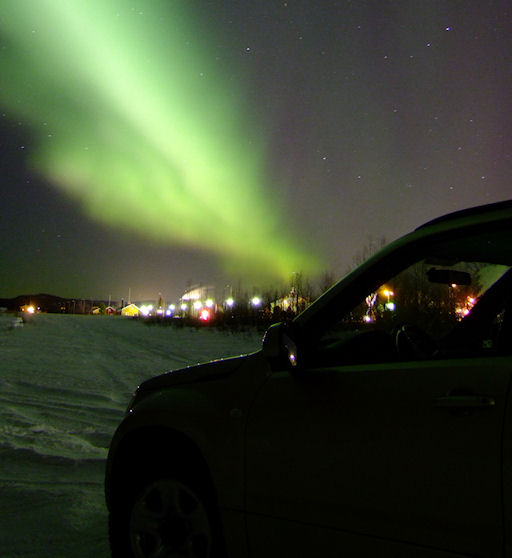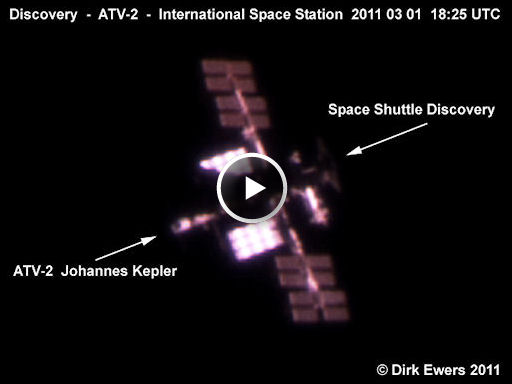Turn your cell phone into a field-tested satellite tracker. Works for Android and iPhone. | | |
FARSIDE ACTIVITY: This morning, March 4th, multiple flares erupted behind the sun's eastern limb. NASA's STEREO-B spacecraft detected a shadowy shock wave in the sun's atmosphere while the Solar and Heliospheric Observatory (SOHO) recorded at least two plasma clouds billowing into space. Today's blasts were not Earth-directed, but future blasts could be geoeffective as the active zone turns toward our planet in the days ahead.
AURORA WATCH: A high-speed solar wind stream is buffeting Earth's magnetic field and lighting up the Arctic Circle with auroras. Last night in the Finnish town of Salla, B.Art Braafhart pulled over for a snapshot:

Photo details: Fujifilm Finepix S100FS, f2.8, ISO 400, 13-30 sec.
"For a moment the 'flames' were so intense, the picture was totally overexposed!" says Braafhart. "After that, we saw a variety of dancing shapes--curtains, screws, omegas, rays. It was an evening not to forget!"
High latitude sky watchers should remain alert for auroras as the solar wind continues to blow.
SPACE STATION FLYBYS: On March 1st, the International Space Station flew over Germany with a double-docking of spacecraft alongside. Both space shuttle Discovery and Europe's new Kepler robotic supply ship were mated to the outpost, providing an extra-large target for backyard telescopes. Click on the image to enjoy the view through astrophotographer Dirk Ewer's 5-inch refractor:

"It was impressive to see the shifting colors of the main solar panels as the sun-angle changed during the overpass," says Ewers. "I also liked the 3-dimensional feel created by Discovery's shadow playing across the station's exoskeleton."
More flybys like this are in the offing--both for Europe and North America. Check the Simple Satellite Tracker (or your cell phone) to find out when to look.
more images: from Pawel Warchal of Cracow, Poland; from Andy Cade of London, England;
NanoSail-D Photo Gallery
[NASA: Solar Sail Stunner] [Photo Contest]
February 2011 Aurora Photo Gallery
[previous Februaries: 2010, 2009, 2008, 2007, 2006, 2004, 2003, 2002]
Potentially Hazardous Asteroids (
PHAs) are space rocks larger than approximately 100m that can come closer to Earth than 0.05 AU. None of the known PHAs is on a collision course with our planet, although astronomers are finding
new ones all the time.
On March 4, 2011 there were 1203 potentially hazardous asteroids.
Notes: LD means "Lunar Distance." 1 LD = 384,401 km, the distance between Earth and the Moon. 1 LD also equals 0.00256 AU. MAG is the visual magnitude of the asteroid on the date of closest approach. | | The official U.S. government space weather bureau |
| | The first place to look for information about sundogs, pillars, rainbows and related phenomena. |
| | Researchers call it a "Hubble for the sun." SDO is the most advanced solar observatory ever. |
| | 3D views of the sun from NASA's Solar and Terrestrial Relations Observatory |
| | Realtime and archival images of the Sun from SOHO. |
| | from the NOAA Space Environment Center |
| | the underlying science of space weather |
| | for out-of-this-world printing and graphics |

